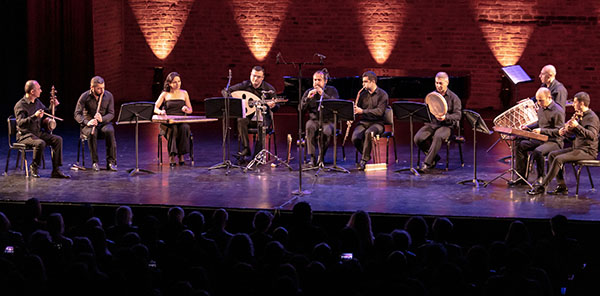The Peter Jay Sharp Theatre at New York’s renowned Symphony Space was filled with applause as hundreds of Komitas enthusiasts, Armenian and non-Armenians alike, stood to their feet for an encore from the critically acclaimed Gurdjieff Ensemble on the night of Friday, September 27th. The concert, organized by AGBU’s Performing Arts Department (PAD) in celebration of Komitas’ 150th Anniversary, was the second stop in the Ensemble’s American debut tour, performing only one day after appearing before a packed house at the World Music Festival in Chicago.
The performance was planned with AGBU’s PAD’s mission in mind to support and present emerging and established artists as well as continuing its initiatives to connect rich Armenian art to diverse audiences. Akin to Komitas, composer and spiritual leader G.I Gurdjieff, the namesake of the Ensemble, travelled the world collecting and preserving ethnographic melodies. With over a century separating Komitas and audience members, the Ensemble’s concert linked people from all over New York to the rich cultural legacy of Armenian music.
The AGBU PAD has been proudly collaborating with the Gurdjieff Ensemble since 2013 through AGBU’s Musical Armenia Program (MAP), which connects students to the best Armenian musicians in Yerevan. Director Hayk Arsenyan was excited to present the Gurdjieff Ensemble because of its unique approach of interpreting Komitas’ music. “The concert was programmed to showcase American music spanning thousands of years,” Arsenyan noted, “from the pre-Christian dances of Msho Shoror to the 10th century music of St. Gregory, and later the music of Gurdjieff and Komitas.”

The 10-member Gurdjieff Ensemble performed on 16 different traditional instruments. Photo credit: Harout Barsoumian.
Lusine Grigoryan, one of Armenia’s most preeminent pianists, captivated the audience with her piano performance, which was showcased to mirror the Ensemble’s performance of piano works. Musical Director Levon Eskenian explained that most of the original music of Gurdjieff was composed for the piano, thus the Ensemble was faced with the challenge of interpreting piano notes to an assortment of different instruments. Yet, it tackled this challenge with grace and spirit, using traditional Armenian instruments such as the tar, kamancha, duduk, zurna, oud, and kanon. Aramayis Nikoghosyan, oud player of the Ensemble, added his own spin by including the kshots, the flabellum used in the Armenian Divine Liturgy (Badarak), emphasizing the spiritual elements of Gurdjieff’s traditions.
Read also
Not only were audience members taken through a voyage through time, they were also taken to various regions of the world. The program featured music from Karin, Mush, and other areas of Asia.
Moments of haunting duduk notes were juxtaposed with vibrant percussion sounds of the tmbuk, taking the audience on an expedition through the vast extent of Armenian music. “There is a new language in classical music based on Armenian music and instruments,” Eskenian remarked.
The Gurdjieff Ensemble did indeed share this new language with audience members, as many musicians took turns using several different Armenian instruments in the span of one song. In total, 16 different instruments were used in their performance, illustrating the harmonious expertise of each musician.
Msho Shoror, the final work performed before the encore, was originally “an ancient piece from seven traditional dances that thousands danced to in the St. Garabed Monastery, which is no longer standing, explained Eskenian. The Monastery predates Christian times and later became an important pilgrimage site. “Though the monastery was destroyed, we still have the music.”
Evidently, attendees left with a lingering connection to the music of the 10th century and the historic melodies preserved through the genius of the Gurdjieff Ensemble.
The Armenian General Benevolent Union (AGBU) is the world’s largest non-profit organization devoted to upholding the Armenian heritage through educational, cultural and humanitarian programs. Each year, AGBU is committed to making a difference in the lives of 500,000 people across Armenia, Artsakh and the Armenian diaspora. Since 1906, AGBU has remained true to one overarching goal: to create a foundation for the prosperity of all Armenians. To learn more visit www.agbu.org.
AGBU Press Office





























































